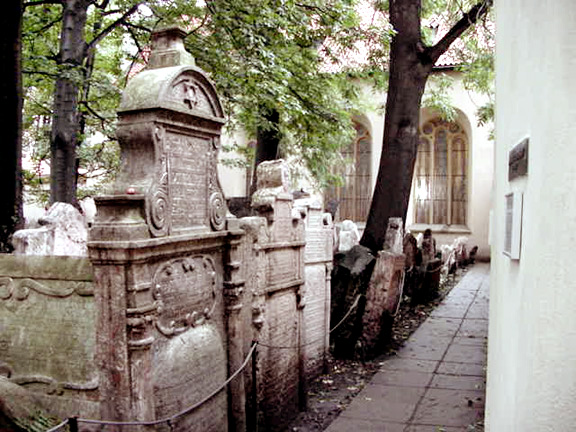Old Jewish Cemetery in Josefov
 Narrow walkway with
Pinkas Synagogue in the background
Narrow walkway with
Pinkas Synagogue in the background
The entrance to the Old Jewish Cemetery
in the Josefov ghetto in Prague is through the courtyard in front
of the Pinkas Synagogue and the exit is near the door to the
Klausen Synagogue. The cemetery opens at 9:00 a.m. and it is
best to get there early since this is one of the biggest tourist
attractions in Prague.
Men are required to cover their heads
before entering the cemetery. Any kind of head gear is fine,
including baseball caps, and paper hats are provided for those
with bare heads. If you want to visit the Old Cemetery, but not
the synagogues, you can buy a single ticket, which is good only
for admission to the cemetery, at any of the ticket booths located
at the synagogues.
No photography is allowed in any of the
synagogues, but photographs of the cemetery are permitted. In
the picture above, you can see some of the more elaborate tombstones
with inscriptions in Hebrew, detailing the lives of the more
prominent Jews buried here. Ropes along the walkway prevent the
hordes of tourists from tromping through the jumbled tombstones.
Many well-known Jews are buried in the
Old Jewish Cemetery, but the famous writer Franz Kafka is not one of them. The Old Jewish
Cemetery was closed in 1787, almost a century before Kafka was
born in 1883. Kafka died at the age of 40 in 1924 and is buried
alongside his parents, both of whom outlived him, in the New
Jewish Cemetery in the district of Zizkov in Prague.
The most famous grave in the Old Cemetery
is undoubtedly that of Rabbi Judah Loew ben Bezalel, whose tombstone
faces the path that you see to the right in the photograph above,
and is shown in the photograph below. You can see a bit of the
path on the extreme left of the photograph. In the background
you can see the Ceremonial Hall which is near the exit of the
Cemetery. The Renaissance tomb of Mordechai Maisel, who built
the Maisel Synagogue, is about ten meters to the southwest of
the Rabbi's grave.
 Tombstone of Rabbi
Judah Loew (1525 - 1609)
Tombstone of Rabbi
Judah Loew (1525 - 1609)
Rabbi Loew (sometimes spelled Löw)
is revered as the legendary creator of the "golem"
which is the Jewish version of the Frankenstein monster, although
golem stories predate Frankenstein, going as far back as the
5th century. Rabbi Loew lived in the 16th century but the legend
of his creation of a monster from the mud of the Vltava river
in Prague only dates back to the 18th century when the story
was first told.
Yossel, as the golem was called, came
to life when the Rabbi placed a shem in its mouth. (A
shem is a tablet with a Hebrew inscription.) Yossel is said to
have aided Rabbi Loew in his struggle with the anti-Semites in
the court of Rudolf II, the Hapsburg Emperor who was then the
ruler over what is now the Czech Republic, but was at that time
part of the Austrian empire.
In his book "The Golem," Elie
Wiesel wrote that Rabbi Loew was called "the Maharal"
which means "most venerated teacher and rabbi." Wiesel
wrote that the Maharal and Emperor Rudolf II met on the Charles
Bridge in 1583 and the king invited him to his court, which he
had just moved from Vienna to Prague. They became friends and
Rabbi Loew became a Hofbefreiter Jude or "Court Jew."
He was frequently able to intercede on behalf of the Jews who
were being routinely persecuted at that time.
Legend has it that the golem finally
ran amok and the Rabbi had to interrupt his Sabbath service in
the Synagogue to deal with it. His congregation kept repeating
the verse in the psalm that they had been reciting until the
Rabbi returned. To this day, at the Old-New Synagogue, a line
in the Sabbath service is repeated in memory of this event.
The end of the golem came when the Rabbi
removed the shem from its mouth; he allegedly carried the remains
of the golem to the attic of the Old-New Synagogue where they
supposedly reside to this day. After visiting the grave of Rabbi
Loew, tourists can buy a golem statue from one of the souvenir
stands along the street where they exit the cemetery.
|